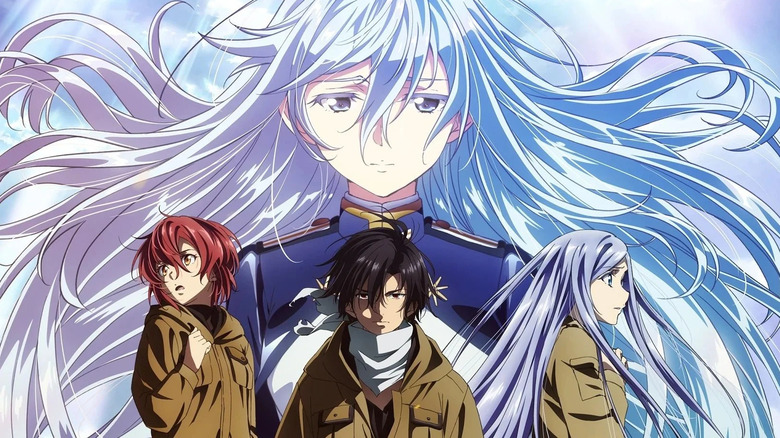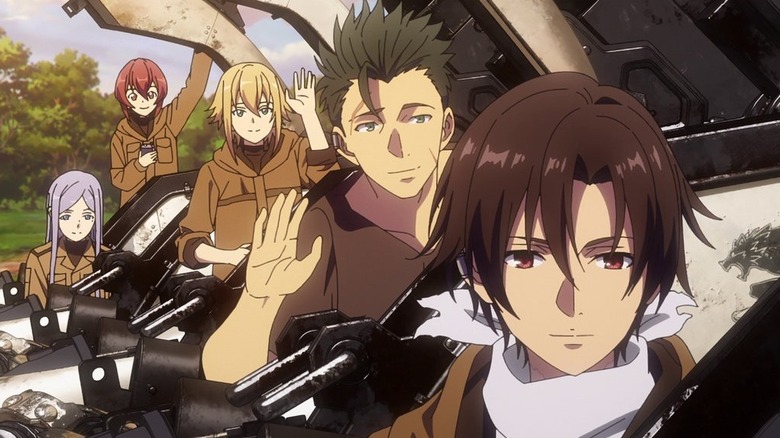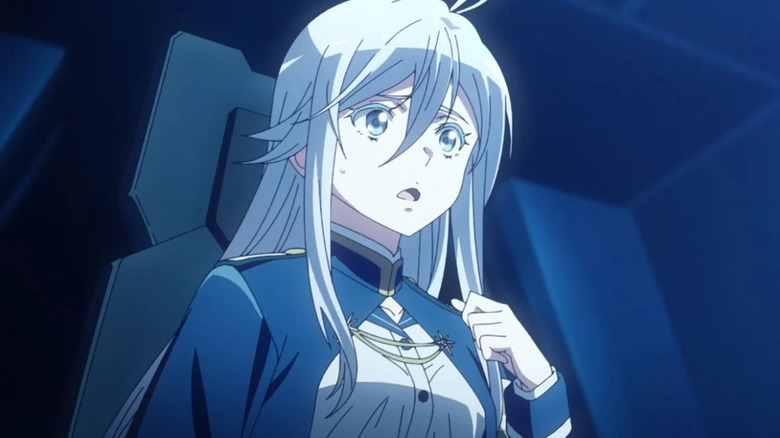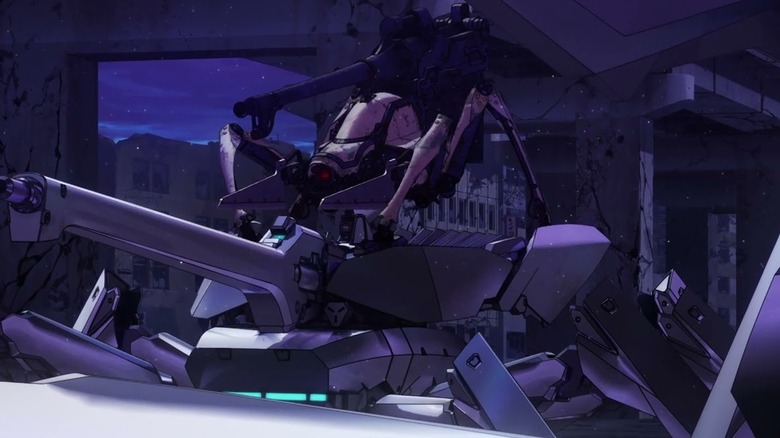86 Eighty-Six Is One Of The Best War Anime Ever Made
(Welcome to Ani-time Ani-where, a regular column dedicated to helping the uninitiated understand and appreciate the world of anime.)
The thing about action anime, especially anime about war and the cost of it, is that they have to make the action engaging to the audience, and in the process end up glorifying it to the point where it renders any anti-war message moot. Sure, there are a few shows that manage to succeed at making you feel bad for liking the action, like most "Gundam" shows, but most still end up being too much fun that you end up forgetting you're watching child soldiers fight to the death.That is not the case with "86 Eighty-Six."
In the anime, which is based on the series of light novels by the same name from Asato Asato, the Republic of San Magnolia has been waging war against the still-functioning autonomous army of drones of a long-dead Empire with their own army of mechanical, "ethically responsible" unmanned drones that result in zero human casualties ... or so they tell the public. In reality, the Republic's army consists of the children of ethnical minorities that the country has rounded up, written off as non-human, and sent to a segregated district 86.
The show follows Lena, a major in the Republic army and the handler of a team of 86, as she discovers that the war is not going as well as the Republic likes to report, and tries to do something about it. From there, the show evolves into a poignant exploration of systematic racism, segregation, and a fantastic interrogation of privilege and white savior tropes, all while delivering a kick-ass war drama with a lot of attention to detail in the artillery department. This is a rare war story from a female creator, and also one of the best anime of 2021.
What Makes It Great
Not unlike "Attack on Titan," we're thrown into a world on the verge of annihilation where the ones on top are living comfortably and blissfully unaware of their own impending doom. From the first episode, "86" does a great job of slowly building its world, dropping small visual hints at a larger story and a larger conflict. There are plot twists upon plot twists that radically change the face of the war without feeling like huge left turns.
The show mostly accomplishes this by splitting the narrative in half, with most of the episodes of the first season cutting away between Lena and Shin, the leader of the Spearhead Squadron on the front lines. We see beautifully storyboarded action scenes from the Spearhead's perspective before replaying the entire sequence from Lena's side, as she is sitting perfectly still in front of a monitor, observing anonymous dots on a screen disappearing one by one. With this, the show constantly draws attention to its themes of racism and prejudice, showing Lena's luxurious and worry-free life in the city, before immediately cutting to Shin and his comrades on the verge of death, emphazasing the systemic racism that allows kids to be written off as non-human pigs just so the silver-haired people in charge won't have to feel bad about war casualties.
And yet, the animation does make for a very compelling and engaging show, even if the action is not exactly the selling point Bandai Spirits was hoping for when they helped fund the show to push sales for their model kits of the main spider mechs. Studio A-1 Pictures delivers thrilling kinetic action that shows the spider mechs jump and slide around the battlefield like a mechanical Spider-Man, while also cutting to close-ups of the members of Spearhead Squadron to contrast the claustrophobic horror they go through. These are not huge, thick robots like the Gundam, but light aluminum coffins that blow up easily, with guns that run out of ammo and can jam at any time, and the anime is constantly reminding us of that. Indeed, artillery nerds should have a blast examining all the nuances "86" adds to its fighting drones.
The action is also aided by an electrifying score by Hiroyuki Sawano, the Hans Zimmer of anime responsible for other badass scores for projects like "Attack on Titan," "Promare," and "Mobile Suit Gundam Unicorn." Where his music can sometimes distract from what is happening on the screen, his score for "86" perfectly follows the rhythm of the story, increasing the tempo along with the action while slowing down during periods of downtime. Though "86" can and does deliver excellent action sequences with surprisingly effective CG animation, it also knows when to slow down and allow absolute silence to take over for dramatic purposes. Shell impacts deafen the battlefield, or the dead quiet before a fight is interrupted by a single cicada reminding us that there is still natural life beyond the death and carnage of battle. This is a slow burn of a show that pays as much attention to its engaging fights as it does to the kids simply being kids before their next assignment.
A war story, especially one focused on a single squadron, would not be effective if the audience didn't care for the team, and "86" excels at making you fall for these teens before mercilessly taking them away from us — and even using an emotionally devastating yet handy frame during the opening title sequence to update us on who has died after each episode. Despite a great attention to detail given to many plot twists regarding the enemy drones, the show often pulls back to give the Spearhead Squadron time to just be teens, gossip about their comrades, look at the stars and contemplate the possibility of surviving the war.
What It Brings to the Conversation
Though the action sequences are thrilling, "86" never stops reminding you that you're watching child soldiers being sent to die by a nation that wants to exterminate them out of sheer racism. Whether it's plot developments about the status of the 86 within the Republic, or something as simply as calling out the audience for not remembering the characters' names, the anime is constantly reminding you of the fact that yes, you can and should enjoy the cool fights, but you should not take it for granted and forget the gravitas of the situation. Erich Maria Remarque's "All Quiet on the Western Front" is name-dropped in one episode, and that novels' influence can be felt throughout the anime, both in terms of the pain that these soldiers are going through on the battlefield, but also their experience outside of it. Yes, the show has as much subtlety as a sledgehammer, but it works because the show keeps doubling down on its themes.
And yet, as painfully unsubtle as the show is when it comes to its portrayal of segregation and systematic racism — the prejudice-conditioned citizens of the Republic are literally all white or silver-haired, while everyone else is considered non-human swine — the show doesn't rely on, say, armbands with star symbols on them to evoke problematic imagery. Instead, "86" is less interested in showing overtly racist commanders than it is on showing how people can sympathize with the oppressed, yet do absolutely nothing to stop it or speak out against it because they think it is pointless.
But where "86" shines brightest is in its calling out Lena for her privilege and white savior narrative. Unlike "Code Geass" and Suzaku, who tried to change the system from within and did not realize how he was becoming part of the problem, the Spearhead Squaron doesn't take Lena's niceties at face value. She may be the first commander who has taken an interest in their well-being and who feels genuinely sad when one of them dies, but at the end of the day she is still sitting safely in a fortress, watching dots on a screen do all the fighting. The season's most poignant moment comes when a member of the Spearhead unit lashes out at Lena for showing fake sadness over the death of a soldier even as she never even learned the names of the soldiers fighting for her, calling them by their monickers like every other commander before her, whether they were sympathetic to the 86 or not. Lena's arc is not as much about confronting or tearing down the system and becoming a white savior, but learning how her privilege can help the 86, even if she still acknowledges that she hasn't and will not step foot on the actual battlefield.
Why Non-Anime Fans Should Check It Out
Many war stories have played out the "faceless army is actually made up of people" angle, like "Ender's Game," but what sets "86" apart is that it knows when to deliver stunning action and an ever-evolving story while still calling out all the problems with those type of stories. What at first may seem like a rather problematic and dull premise quickly evolves into one of the most complex, fascinating and poignant war tales in the last few years, and one of the best anime of the year.
Watch This If You Like: "Code Geass," "Attack on Titan," "Ender's Game."
"86 Eighty-Six" is streaming on Crunchyroll.



